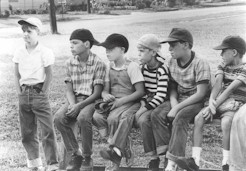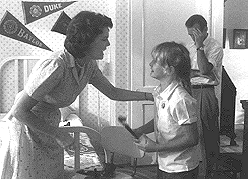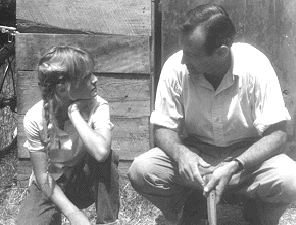
Study Guide
SUMMER’S END has been used extensively for the study of short story
structure in junior high and senior high school English and creative writing classes.
 A "Teacher’s Note" precedes a Study Guide that was
conceived and written by Bonnie Anthony Routon, Hope High School, Hope, Arkansas. A "Teacher’s Note" precedes a Study Guide that was
conceived and written by Bonnie Anthony Routon, Hope High School, Hope, Arkansas.
Teacher’s Note:
"Beth Brickell’s award-winning film is an extremely
effective teaching tool for use with middle school and high school students. The
story’s theme of individuality and motif of the status of women are relevant to male
and female students in their time of searching for their own identities during their early
teens. Summer’s End evokes strong responses in students concerning their
relationships with family and peers. I have been amazed at how easy this film makes my job
of teaching students the basic structure of drama and the short story, as well as the
components of writing. Even the shyest student raises his or her hand and wants to join in
class discussions about the conflicts among Kath, her family and friends in Clarendon,
Arkansas at the end of the summer of 1948."
Bonnie Anthony Routon
Hope High School
Hope, Arkansas
Thematic Questions:
- The film opens with a baseball game in which we are introduced to
Kath, the protagonist, for the first time. Why do you think the filmmaker doesn’t
reveal to us at first that Kath is a girl? How did you feel when you found out?
- The central conflict in the film arises from Kath’s mother
wanting Kath to have her hair styled. Why do you think her mother wants Kath to get a
permanent? Do her reasons make sense to you? Why do you think Kath is so determined to
keep her braids?
- How are Aunt Estelle’s children different from Kath and Ray
Junior? Why do you think they developed differently?
- Much of the thematic content of Summer’s End revolves
around the idea of individuality. How would you define "individual?" Do you
agree with the father’s definition ("somebody who’s not like everybody
else")?
- List five games the children play and explain their relationship to
the film’s theme of being true to oneself.
- Who calls Kath a "sissy" and under what circumstances?
What do you think he really means? Why does Kath consider it a great insult to be called a
sissy? Kath’s father says that a sissy is a coward and that Kath could never be a
coward. Do you agree with his definition? Do you agree with his judgment of Kath?
- What’s special about Kath’s relationship with her friend
Jeeter?
- Kath and Jeeter stop to play marbles with two of the neighborhood
boys and they get into a fight. When Kath’s mother hears about it from the boy’s
mother, she agrees that "nothing is uglier than a little girl fighting." Do you
agree with Kath’s mother? Why did Kath get into the fight? Does this justify her
behavior?
- In one discussion Kath’s mother says, "What Kath wants is
not always what’s best for her." Later, she says that Kath is "getting to
be as bad as my cousin Shirley. We all just hated her. We didn’t want her to play
with us or do anything we did." Then she says, "She’s not going to know
what it is to be a girl. Don’t you see that it’s just confusing her?" Do
you think Kath’s mother is right to be concerned? Why or why not? Have there been
times when you’ve been left out because you were different?
- Kath’s father has a different view of the situation. He says
that Kath just needs a little more time and that’s it’s all right for her to
pursue her own interests. Do you agree with his position? Why or why not? Do you think it
was right for him not to take down Kath’s clubhouse after he said he would? Why?
- At the end of the film, why does Kath decide not to cut off her
curls?
- How would you describe the central theme of Summer’s End?
What point of view does the filmmaker express through the film?
- Summer’s End
is the story of a particular little girl in a
specific time and place. Do you think the film’s theme could apply to other people in
other situations? In what ways is the theme universal?
Structural Questions:
- How does the filmmaker make you aware of everyday life in small-town
America in the 1940s? Besides the many games played by the children in the movie, describe
five other examples of local color.

- How does the filmmaker make you care about the protagonist?
- Different movies – as well as books and other narrative art
forms – use time in different ways. How does the filmmaker tell her story in Summer’s
End? Do all of the events happen one after another? Do some scenes actually take place
at the same time in different locations? Give examples. What events take place without our
actually seeing them? How do we know that they happened?
- Identify some of the minor characters in Summer’s End
and explain how the filmmaker uses them to advance the plot and to highlight her themes.
- All narratives have a beginning, middle and end. How could you
divide Summer’s End into three sections – introduction, development and
conclusion? What actions take place in each section? What decisions does Kath make at the
end of each section? (Answer: To run away, to come home, not to cut off her curls). Can
you think of how other movies you’ve seen fit this pattern?
Assignments:
TV COMMERCIAL:
Divide students into groups of three or four and instruct them to
prepare a TV commercial for the purpose of selling Summer’s End to viewers of
all ages. These may be videotaped and you may wish to emphasize costumes, backgrounds,
etc.
ROLE PLAY:
- Students act out a scene of conflict of their choice from the film.
- Students act out an imagined scene with Kath and her mother on a
Girl Scout camping trip the following weekend.
- Students act out a birthday party scene with Kath before she
changes, and one after she has the permanent her mother so badly wants her to have.
WRITING EXERCISES FOR ADVANCED STUDENTS:
- Ask students to close their eyes and remember a time of conflict in
their childhood. Have them recall the tastes, sounds, sights, smells and emotions that
they experienced at the time. Then have them open their eyes and quickly write down words
that come to mind. Have them describe the basic conflict. What caused it? How was it
resolved? Finally, ask the students to organize their notes into a time sequence and
compress the entire action into a 24-hour period. They may then add or subtract details,
changing the memory into a fictionalized account.
- Instruct students to:
- Recall a turning-point experience in their lives.
- Sequence the events in chronological order on a story time-line.
- Describe the setting by using titles of music, movies or TV shows
and ways the characters spend their time.
- Describe the clothing, automobiles and food.
- Vividly, using conversation and action, depict three conflict
scenes.
- Rewrite after reading to a friend and having a friend read aloud.
- Clarify any sections by adding more details.
- Eliminate unnecessary words and scenes.
- Turn in final draft of minimum of 1,000 words.
|
 A "Teacher’s Note" precedes a Study Guide that was
conceived and written by Bonnie Anthony Routon, Hope High School, Hope, Arkansas.
A "Teacher’s Note" precedes a Study Guide that was
conceived and written by Bonnie Anthony Routon, Hope High School, Hope, Arkansas.
